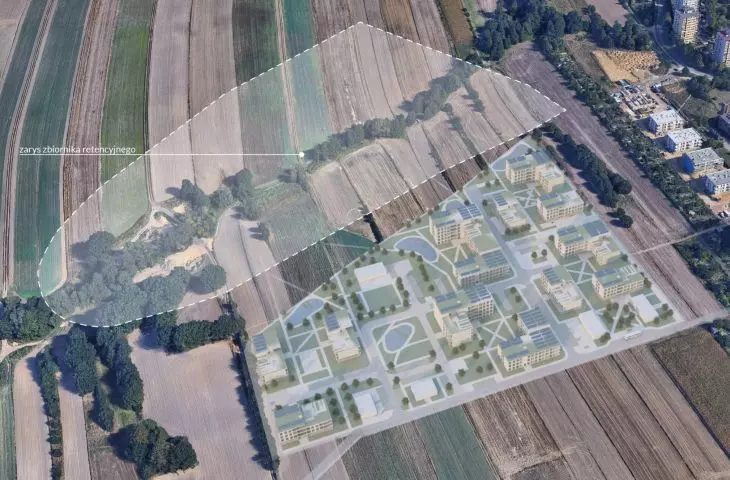Work submitted for the competition
"Best Diploma Architecture".
The engineering project was created on the basis of a theoretical concept using models of the Settlement Game. A location was chosen in Gliwice, near the border of the Sikornik estate, near a dry retention reservoir. The main premise of the project was an ecological approach to urban and architectural planning. Numerous pro-environmental solutions focusing on various methods of rainwater retention were applied, including the use of permeable pavements and the design of retention tanks. The buildings were constructed in wooden frame construction with green roofs.
Work on the project was divided into stages: creation of urban concepts, urban design on a scale of 1:1000 and 1:500, and architectural design of the selected building.
Four urban concepts were created for the selected area, using models of the Settlement Game. Basic cards with the highest values were selected, as well as joker cards. The resulting variants are designed to compare the urban indicators calculated for the cards with those specified in the Local Development Plan.
Concept 1 is an ecological proposal with the largest amount of biologically active areas, a sports field and multiple bodies of water.
Concept 1, axonometry
© Marta Sanigórska
Concept 2 is a combination of the role of the resident and the urban planner, trying to maintain a balance between buildings and greenery. Service buildings and recreational areas also appear here.
Concept 2, axonometry
© Marta Sanigórska
Concept 3 depicts the developer's vision with the highest value of the development intensity ratio among the concepts listed above and numerous service areas.
Concept 3, axonometry
© Marta Sanigórska
In addition, an extreme concept was created, which consists of cards of the developer with the highest value of the development intensity index. It is intended to show how high and how intensively a site can be developed while maintaining the provisions of city documents.
Concept 4, axonometry
© Marta Sanigórska
Concept 2 was chosen as a guideline for further engineering design. The 1:1000 scale site design includes residential buildings with a stepped block form. The heights of the floors range from three to five and increase with the slope of the development site to the north, which helps reduce the difference in site height. The first floors of some of the buildings provide for commercial premises. Some of the vehicular traffic is designed as pedestrian and vehicular routes to reduce traffic speeds.
Concept 2, projection
© Marta Sanigórska
A total of five underground parking lots have been established on the site, and five retention basins have been planned, allowing for more efficient drainage of rainwater and natural use of the slope of the land.
The scope of the study, at a scale of 1:500, covers an area the size of one card for the Estate Game. The designed quarter includes two buildings on a rectangular plan and one on an L-shaped plan. Along the southern boundary of the site, the main axis of vehicular and bicycle transportation was laid out. A pedestrian and vehicular route was established at the western edge.
{img-10:width=100%,height=auto}
A green courtyard with low vegetation is located between the buildings, and container rain gardens are provided next to the buildings themselves. Larger trees are located at the boundaries of the site and in the northern part, where a retention basin and playground are also designed.
visualization
© Marta Sanigórska
Designed on a finer scale, the building has four floors above ground and one underground. It has been designed with mixed technology: the underground floor, the first floor of the building and the staircase have been founded on a reinforced concrete structure, while the upper floors have been designed with a timber frame, modular construction.
cross-section and elevation
© Marta Sanigórska
The structure of the building consists of a first floor with two commercial units, as well as residential floors. A total of sixteen apartments with loggias are located in the building. From the +3 floor one can access a public terrace, while photovoltaic panels have been placed on the higher part of the roof and a green roof has been established. The underground contains a garage and storage rooms.
Marta SANIGÓRSKA
Illustrations: © Author


































































